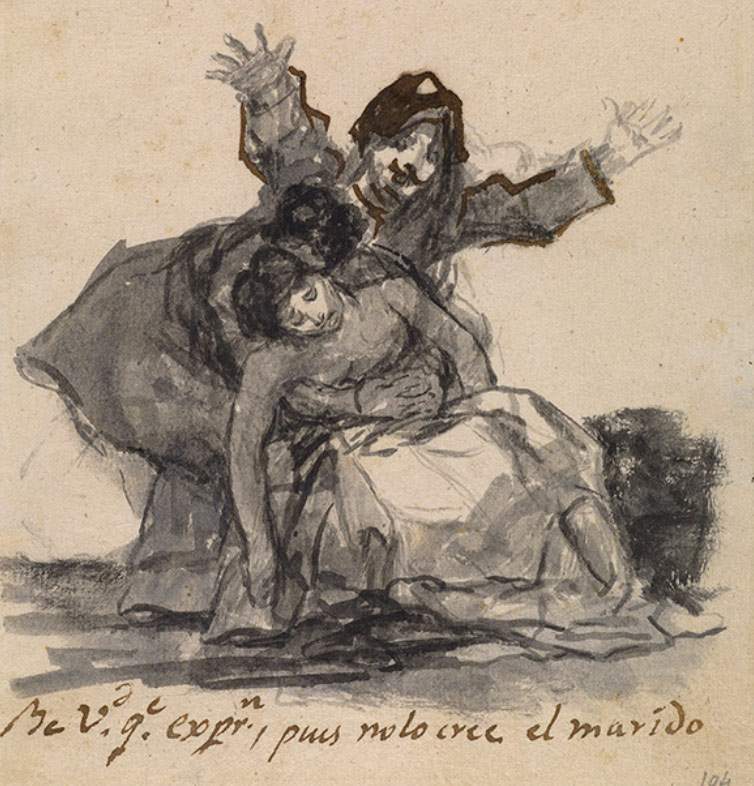Coming out in bookstores on June 18 is an important publication resulting from the collaboration between the Prado Museum in Madrid and the Skira publishing house: it is the full and faithful reproduction of the famous Cuaderno C by Francisco de Goya y Lucientes (Fuendetodos, 1746 - Bordeaux, 1828), the notebook composed by the great Spanish artist between 1814 and 1823. Originally, it consisted of 133 or more sheets (the last numbered drawing is in fact 133 but we do not know if there were more): at the Prado, since 1872, 120 are preserved, having arrived in an album at the Museo de la Trinidad. Thus there are 13 missing from the Prado collection, and of these only 5 are known ones: 71 and 128 (kept at the Hispanic Society of America), 88 (at the British Museum), 78 (at the Getty Museum in Los Angeles) and 11 (kept in a private collection). The remaining 8 (14, 15, 29, 56, 66, 72, 110 and 132) are still unknown.
The product of Goya’s keen eyesight, developed during the Spanish War of Independence (which pitted Spaniards, Portuguese and British against Napoleon between 1808 and 1814) and the years of repression that followed (until 1820), Cuaderno C offers an often disturbing view of Spanish society at the time: there are scenes of daily life marked by poverty, prisoners of the Inquisition, scenes of cruelty in prisons, dreamy visions of the night world. All images that we still associate with Goya’s repertoire today. Another group of drawings shows the consequences of the confiscation of church property that led to the closure of many monasteries and convents, forcing monks and nuns to renounce their vows and begin a new life outside the safety of their walls. Finally, liberty, reason, and justice are the subjects of a further group of drawings that attest to Goya’s hopes for the reform policies of the Liberal Triennium (1820-1823).
“It has been hypothesized that Notebook C,” José Manuel Matilla, senior curator of the Drawings and Prints Department, writes in the accompanying essay, “was a kind of graphic diary in which Goya illustrated all his concerns, particularly those concerning the fate of the most miserable and marginalized, those who in one way or another suffered the economic, social and political consequences of the postwar period, the victims of circumstances with whom the now elderly artist, deaf and in a precarious financial and political situation because of his own ideas, could largely identify. The heartbreak that pervades these sheets is perhaps an expression of the artist’s personal suffering, and the pessimism that shines through the drawings is that of a man deeply disgusted with his surroundings.”
Skira’s volume reproduces all the known drawings, including the captions affixed by Goya. “The captions in the author’s own hand, which often serve as the title or commentary to the various images,” Matilla further points out, “are revealing, since the double meaning on which they play invites reflection on the real intention that animates them. In this sense, the word and the image form an indissoluble whole and must be received in unison. Moreover, words often build a trait d’union between the various drawings, concatenating works that acquire their actual meaning when they are read in succession, like the pages of a book. Only in this way is it possible to grasp the sequences and thematic groups conceived by Goya during the elaboration of Notebook C.”
The book, in Italian, Spanish, French, German and English editions, consists of 306 pages (130 images), in a 16.5 x 25.5 cm hardback format, and costs 40 euros. Information can be found on Skira’s website.
Pictured is a detail of sheet 19.
 |
| Francisco Goya's Cuaderno C: Skira and the Prado in Madrid publish a full and faithful reproduction |
Warning: the translation into English of the original Italian article was created using automatic tools. We undertake to review all articles, but we do not guarantee the total absence of inaccuracies in the translation due to the program. You can find the original by clicking on the ITA button. If you find any mistake,please contact us.